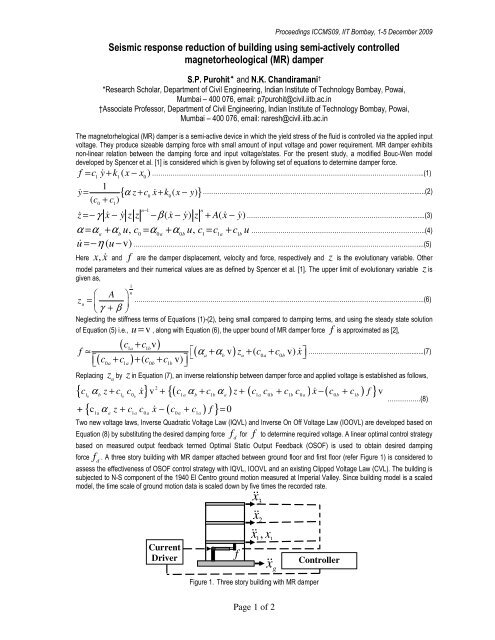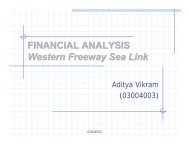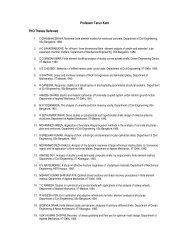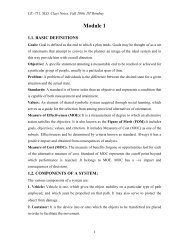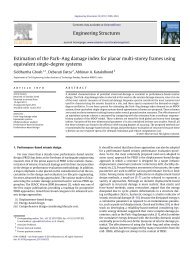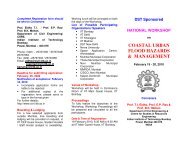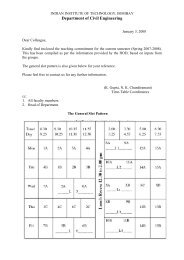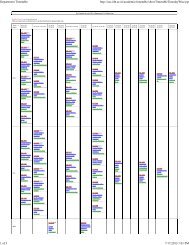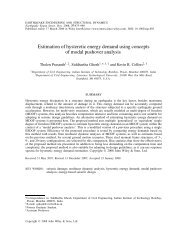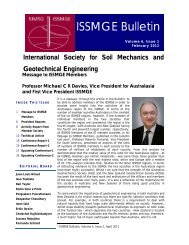pdf file - Department of Civil Engineering, IIT Bombay - Indian ...
pdf file - Department of Civil Engineering, IIT Bombay - Indian ...
pdf file - Department of Civil Engineering, IIT Bombay - Indian ...
You also want an ePaper? Increase the reach of your titles
YUMPU automatically turns print PDFs into web optimized ePapers that Google loves.
Proceedings ICCMS09, <strong>IIT</strong> <strong>Bombay</strong>, 1-5 December 2009<br />
Seismic response reduction <strong>of</strong> building using semi-actively controlled<br />
magnetorheological (MR) damper<br />
S.P. Purohit and N.K. Chandiramani †<br />
*Research Scholar, <strong>Department</strong> <strong>of</strong> <strong>Civil</strong> <strong>Engineering</strong>, <strong>Indian</strong> Institute <strong>of</strong> Technology <strong>Bombay</strong>, Powai,<br />
Mumbai – 400 076, email: p7purohit@civil.iitb.ac.in<br />
†Associate Pr<strong>of</strong>essor, <strong>Department</strong> <strong>of</strong> <strong>Civil</strong> <strong>Engineering</strong>, <strong>Indian</strong> Institute <strong>of</strong> Technology <strong>Bombay</strong>, Powai,<br />
Mumbai – 400 076, email: naresh@civil.iitb.ac.in<br />
The magnetorhelogical (MR) damper is a semi-active device in which the yield stress <strong>of</strong> the fluid is controlled via the applied input<br />
voltage. They produce sizeable damping force with small amount <strong>of</strong> input voltage and power requirement. MR damper exhibits<br />
non-linear relation between the damping force and input voltage/states. For the present study, a modified Bouc-Wen model<br />
developed by Spencer et al. [1] is considered which is given by following set <strong>of</strong> equations to determine damper force.<br />
…………………………………………………………………………………………………………………..(1)<br />
f = c y&<br />
+ k ( x − x )<br />
1 1 0<br />
y 1<br />
& = { α ( )<br />
0 0 }<br />
( )<br />
z +<br />
c c<br />
c x & + k x −<br />
+<br />
y …………………………………………………………………………………….............(2)<br />
0 1<br />
n−1<br />
n<br />
& & & & & &<br />
z&<br />
=− γ x − y z z −β<br />
( x − y) z + A( x − y)<br />
…………………………………………………………………….........(3)<br />
α = α + α u, c = α + α u,<br />
c = c + c u ………………………………………………………………………...(4)<br />
a b 0 0a 0b 1 1a 1b<br />
u&<br />
=−η<br />
( u − v) …………………………………………………………………………………………………………………………..(5)<br />
Here x,<br />
x& and f are the damper displacement, velocity and force, respectively and z is the evolutionary variable. Other<br />
model parameters and their numerical values are as defined by Spencer et al. [1]. The upper limit <strong>of</strong> evolutionary variable z is<br />
given as,<br />
1<br />
z<br />
u<br />
⎛ A ⎞<br />
= ⎜<br />
γ + β ⎟<br />
⎝ ⎠<br />
n<br />
……...…………………………………………………………………………………………………………………..(6)<br />
Neglecting the stiffness terms <strong>of</strong> Equations (1)-(2), being small compared to damping terms, and using the steady state solution<br />
<strong>of</strong> Equation (5) i.e.,<br />
( c + c v<br />
1a<br />
1b<br />
)<br />
( )<br />
u = v , along with Equation (6), the upper bound <strong>of</strong> MR damper force f is approximated as [2],<br />
( α α )<br />
& ………………………………………….........(7)<br />
f ≈ ⎡ + v z + ( c + c v) x<br />
a b u 0a 0b<br />
⎤<br />
⎡ c c ( c c v)<br />
⎣<br />
⎦<br />
⎣ + + +<br />
0a 1a 0b 1b<br />
⎤⎦<br />
z by z in Equation (7), an inverse relationship between damper force and applied voltage is established as follows,<br />
Replacing<br />
u<br />
2<br />
{ c1 α<br />
1 0 } v {( ) ( ) ( ) }<br />
b b<br />
z + c c x&<br />
+ c<br />
b b<br />
1a α<br />
b<br />
+ c1b α<br />
a<br />
z + c1 a<br />
c0b + c1b c0 a<br />
x&<br />
− c0b + c1b<br />
f<br />
+ { c α z + c c x&<br />
−<br />
1a 1 0 ( c + c<br />
0 1 ) f } = 0<br />
a a a a a<br />
v<br />
…………….(8)<br />
Two new voltage laws, Inverse Quadratic Voltage Law (IQVL) and Inverse On Off Voltage Law (IOOVL) are developed based on<br />
Equation (8) by substituting the desired damping force<br />
f for f to determine required voltage. A linear optimal control strategy<br />
d<br />
based on measured output feedback termed Optimal Static Output Feedback (OSOF) is used to obtain desired damping<br />
force f . A three story building with MR damper attached between ground floor and first floor (refer Figure 1) is considered to<br />
d<br />
assess the effectiveness <strong>of</strong> OSOF control strategy with IQVL, IOOVL and an existing Clipped Voltage Law (CVL). The building is<br />
subjected to N-S component <strong>of</strong> the 1940 El Centro ground motion measured at Imperial Valley. Since building model is a scaled<br />
model, the time scale <strong>of</strong> ground motion data is scaled down by five times the recorded rate.<br />
Current<br />
Driver<br />
f<br />
x&&<br />
3<br />
x&&<br />
2<br />
x&&<br />
1 , x 1<br />
x&& g<br />
Figure 1. Three story building with MR damper<br />
Controller<br />
Page 1 <strong>of</strong> 2
Proceedings ICCMS09, <strong>IIT</strong> <strong>Bombay</strong>, 1-5 December 2009<br />
The equation <strong>of</strong> motion for the three story building is given by,<br />
M x&& + C x& + K x = G f − M L && x ……………………………………………………………………………………....(9)<br />
s s s s g<br />
The state space equation representing building dynamics (Equation (9)) and the output equation are,<br />
q&<br />
= A q + B f + E && x g<br />
………………………………………………………………………………………………………………(10)<br />
y = C q + D f ………………………………………………………………………………………………………..........................(11)<br />
The matrix co-efficients <strong>of</strong> Equation (9) – (10) and their numerical values are as defined by Dyke et al. [3]. The control input (i.e.,<br />
damper force) using OSOF control strategy is given by [4],<br />
f<br />
d<br />
= − K y …………………………………………………………………………………………………………….........................(12)<br />
where, K is the constant feedback gain matrix to be determined. The quadratic Performance Index (PI) defined as,<br />
∞<br />
1 ⎡ T<br />
T ⎤<br />
J = ( f R f ) dt<br />
d d<br />
2 ⎢∫ +<br />
⎣<br />
q Q q ⎥<br />
0<br />
⎦<br />
is used. Here T<br />
Q = C QC ˆ is the positive semi-definite state weighting matrix<br />
with Q ˆ = 1 and R is the positive definite control input weighting matrix. Following Lewis and Syrmos [4], design equations<br />
33<br />
for OSOF control to determine K , which minimizes an optimal cost (i.e., PI) J = 0.5 tr ( PX ) is given as,<br />
T T T<br />
A P + PA + C K RKC + Q =0 …………………………………………………………………………......................(13)<br />
C C<br />
T<br />
A S + SA + X =0 ………………………………………………………………………………………………………………..(14)<br />
C<br />
C<br />
1 1<br />
R − B T PSC T ( CSC T<br />
)<br />
− = K ……………………………………………………………………………………………….....(15)<br />
T<br />
Here, X ≡ q(0) q (0) = I . Coupled nonlinear matrix Equations (13)-(15) are solved by Moerder–Calise iterative algorithm.<br />
To compare the performance <strong>of</strong> OSOF control strategy, an existing control like Passive On and LQG with COC voltage law are<br />
considered and implemented. The building problem is solved using MATLAB and peak response quantities like interstory drift,<br />
displacement, and acceleration are obtained as shown in Table 1.<br />
Table 1. Peak response quantities <strong>of</strong> building subjected to El Centro Ground Motion<br />
Control<br />
Strategy<br />
Uncontrolled<br />
Passive On<br />
LQG – COC<br />
(R = 10 -17 )<br />
OSOF – COC<br />
(R = 10 -17 )<br />
OSOF – IQVL<br />
(R = 10 -06 )<br />
OSOF – IOOVL<br />
(R = 10 -08 )<br />
Displacement<br />
(cm)<br />
Interstory<br />
Drift (cm)<br />
Acceleration<br />
(cm/sec 2 )<br />
0.547 0.547 873.69<br />
0.835 0.318 1069.4<br />
0.971 0.202 1408<br />
0.079 0.079 273.96<br />
0.1952 0.157 495.96<br />
0.3044 0.11 767.15<br />
0.1204 0.1204 757.4<br />
0.1876 0.098 733.08<br />
0.2177 0.106 735.37<br />
0.1203 0.1203 711.19<br />
0.1739 0.100 383.19<br />
0.2392 0.0796 553.86<br />
0.1274 0.1274 717.68<br />
0.1883 0.115 468.98<br />
0.2532 0.0806 561.17<br />
0.1149 0.1149 783.01<br />
0.1578 0.1033 438.1<br />
0.2277 0.0797 554.58<br />
MR Damper<br />
Force (N)<br />
Performance<br />
Index<br />
- -<br />
964.69 -<br />
969.72 7.007<br />
809.21 5.2378<br />
768.5 5.589<br />
905.79 5.5149<br />
It is concluded from the present study that OSOF control works well with MR damper. A reduction in maximum peak interstory<br />
drift and PI is obtained when using OSOF control as compared to passive-on/LQG – CVL control. The peak values <strong>of</strong><br />
accelerations are also reduced via OSOF control, except when considering first storey accelerations using passive-on control.<br />
References<br />
1. Spencer BF Jr., Dyke SJ, Sain MK, Carlson JD, 1996, Phenomenological model <strong>of</strong> a magnetorhelogical damper, ASCE<br />
Journal <strong>of</strong> <strong>Engineering</strong> Mechanics, 123(3), 230-238.<br />
2. Change Chih-chen, Zhou Li, 2002, Neural network emulation <strong>of</strong> inverse dynamics for a magnetorhelogical damper, ASCE<br />
Journal <strong>of</strong> <strong>Engineering</strong> Mechanics, 128(2), 231-239.<br />
3. Dyke SJ, Spencer BF Jr., Sain MK, Carlson JD, 1996, Seismic response reduction using mangetorhelogical dampers,<br />
Proceedings <strong>of</strong> IFAC World Congress, San Franscisco, California, June 30 – July 5.<br />
4. Lewis FL, Syrmos VL, 1995, Optimal Control, John Wiley & Sons, Inc., New York, 359-370.<br />
Page 2 <strong>of</strong> 2


